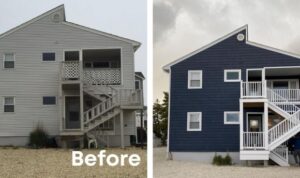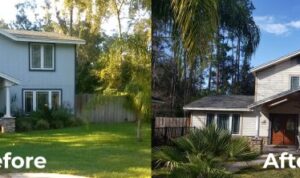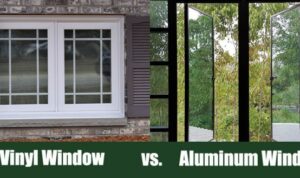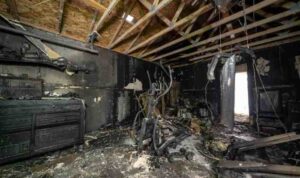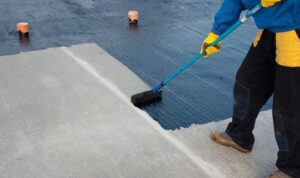Delve into the world of metal siding for houses where durability meets style. Learn about the versatility and benefits of using metal as a siding material, and explore the various design options available to enhance your home's curb appeal.
Introduction to Metal Siding for Houses
Metal siding is a popular choice in residential construction for its durability, low maintenance, and aesthetic appeal. It is used to cover the exterior walls of a house, providing protection against the elements while enhancing the overall look of the property.Metal siding offers several benefits compared to other materials such as wood or vinyl.
It is highly resistant to fire, rot, insects, and mold, making it a long-lasting option for homeowners. Additionally, metal siding requires minimal upkeep and can be easily cleaned with a hose and mild detergent.Common types of metals used for siding include aluminum, steel, and zinc.
Aluminum siding is lightweight, resistant to corrosion, and can be painted in various colors. Steel siding is extremely durable and can mimic the look of wood or stucco. Zinc siding, known for its longevity and self-healing properties, develops a natural patina over time.
Types of Metal Siding
- Aluminum Siding: Lightweight, corrosion-resistant, and customizable with paint.
- Steel Siding: Durable, versatile, and available in a variety of finishes.
- Zinc Siding: Long-lasting, self-healing, and develops a distinctive patina.
Installation Process
When it comes to installing metal siding on a house, following a step-by-step process is crucial to ensure a successful and long-lasting outcome. It is important to have the right tools and materials on hand and to adhere to best practices for durability.
Tools and Materials Required
To install metal siding on a house, you will need the following tools and materials:
- Metal siding panels
- Screws or nails
- Hammer or screwdriver
- Tin snips
- Level
- Tape measure
- Safety glasses
- Gloves
Best Practices for Durability
To ensure the durability and longevity of metal siding on a house, consider the following best practices:
- Properly prepare the surface before installation to ensure a smooth and even application.
- Use appropriate fasteners to secure the siding in place and prevent it from shifting over time.
- Allow for expansion and contraction of the metal siding by leaving space at the ends of each panel.
- Regularly inspect and maintain the siding to address any issues before they escalate.
- Consider adding a protective coating to enhance the durability of the metal siding against elements like rust and corrosion.
Maintenance and Care
Metal siding is a durable and low-maintenance option for houses, but it still requires some care to preserve its appearance and functionality over time. Regular maintenance can help prevent issues such as rust and dents, keeping your metal siding looking great for years to come.
Cleaning Metal Siding
- Regularly wash your metal siding with a mixture of mild detergent and water to remove dirt and grime.
- Rinse thoroughly with clean water to prevent soap residue from causing streaks on the metal surface.
- Avoid using abrasive cleaners or tools that could scratch the metal finish.
- Consider using a pressure washer on a low setting for tough stains, but be cautious not to damage the siding.
Addressing Rust and Dents
- Inspect your metal siding regularly for any signs of rust, and address it promptly to prevent further corrosion.
- To remove rust, scrub the affected area with a wire brush and apply a rust-inhibiting primer before repainting.
- For minor dents, use a rubber mallet to gently tap the metal back into place, being careful not to cause further damage.
- If a dent is too severe to repair yourself, consider hiring a professional to fix it to maintain the integrity of your siding.
Design and Style Options

Metal siding for houses offers a wide range of design and style options to enhance the overall aesthetic appeal of your home.
Various Finishes and Colors
Metal siding comes in a variety of finishes and colors to suit different architectural styles. From sleek and modern to rustic and traditional, there is a finish and color combination to complement any home design. Some popular finishes include matte, satin, and textured options, while color choices range from classic neutrals to bold, statement hues.
Customization for Curb Appeal
One of the key benefits of metal siding is its versatility when it comes to customization. Homeowners can choose from different profiles, textures, and patterns to create a unique look for their home. Whether you prefer a smooth, seamless appearance or want to mimic the look of wood or stone, metal siding can be customized to enhance curb appeal and make a lasting impression.
Cost Considerations

Metal siding for houses can be a cost-effective option that offers both durability and aesthetic appeal. When considering the cost of installing metal siding, it is important to break down the various factors that contribute to the overall expense.
Installation Costs
- The cost of materials: Metal siding materials vary in price depending on the type of metal used, such as aluminum, steel, or zinc.
- Labor costs: Hiring professionals for installation can add to the total cost, but ensures proper installation for long-term durability.
- Additional materials: Other materials such as insulation, flashing, and trim will also contribute to the overall cost.
Long-Term Savings
- Despite the initial investment being higher than other siding options, metal siding can lead to long-term savings due to its durability and low maintenance requirements.
- Metal siding is resistant to rot, pests, and fire, reducing the need for costly repairs or replacements over time.
- Energy efficiency: Some metal siding options are designed to improve energy efficiency, leading to lower heating and cooling costs in the long run.
Economic Benefits
- Increased property value: Metal siding can enhance the curb appeal of a house, increasing its overall value in the real estate market.
- Insurance savings: Some insurance companies offer discounts for homes with metal siding due to its fire resistance and durability.
- Sustainability: Metal siding is a sustainable choice as it can be recycled at the end of its lifespan, reducing environmental impact.
Last Point
In conclusion, metal siding for houses offers a winning combination of strength, longevity, and aesthetic appeal. Make the smart choice for your home by considering metal siding as a durable and stylish option for your residential construction needs.
FAQ Insights
What are the common types of metals used for siding?
Common metals used for siding include aluminum, steel, and zinc. Each metal has unique characteristics that make it suitable for different needs.
How can I maintain metal siding to ensure its longevity?
Maintain metal siding by regularly cleaning it with a mild detergent, checking for any signs of damage, and addressing issues promptly to prevent further deterioration.
Is metal siding cost-effective in the long run?
While the initial investment in metal siding may be higher, its durability and low maintenance requirements can lead to long-term savings compared to other siding materials.

